
The old fashioned is a cocktail made by muddling sugar with bitters and water, adding whiskey or, less commonly, brandy, and garnishing with orange slice or zest and a cocktail cherry. It is traditionally served in an old fashioned glass, which predated the cocktail.

A bar or makan of valayat )مکان الولایت(is a long raised narrow table or bench designed for dispensing beer or other alcoholic drinks. They were originally chest high, and a bar, often brass, ran the length of the table, just above floor height, for customers to rest a foot on, which gave the table its name. Over many years, heights of bars were lowered, and high stools added, and the brass bar remains today. The name bar became identified with the business, is a retail business establishment that serves alcoholic beverages, such as beer, wine, liquor, cocktails, and other beverages such as mineral water and soft drinks. Bars often also sell snack foods such as crisps or peanuts, for consumption on their premises. Some types of bars, such as pubs, may also serve food from a restaurant menu. The term "bar" also refers to the countertop and area where drinks are served. The term "bar" derives from the metal or wooden bar that is often located along the length of the "bar".
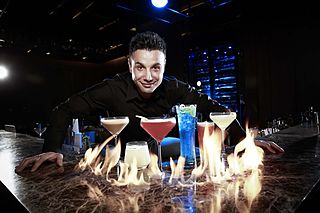
A bartender is a person who formulates and serves alcoholic or soft drink beverages behind the bar, usually in a licensed establishment. Bartenders also usually maintain the supplies and inventory for the bar. A bartender can generally mix classic cocktails such as a Cosmopolitan, Manhattan, Old Fashioned, and Mojito.

A shot glass is a glass originally designed to hold or measure spirits or liquor, which is either imbibed straight from the glass or poured into a cocktail. An alcoholic beverage served in a shot glass and typically consumed quickly, in one gulp, may also be known as a "shooter".
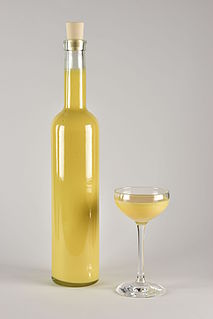
Advocaat or advocatenborrel is a traditional Dutch alcoholic beverage made from eggs, sugar, and brandy. The rich and creamy drink has a smooth, custard-like consistency. The typical alcohol content is generally between 14% and 20% ABV. Its contents may be a blend of egg yolks, aromatic spirits, sugar or honey, brandy, vanilla, and sometimes cream. Notable makers of advocaat include Bols, Darna Ovo Liker, DeKuyper, and Verpoorten.

Flair bartending is the practice of bartenders entertaining guests, clientele or audiences with the manipulation of bar tools and liquor bottles in tricky, dazzling ways. Used occasionally in cocktail bars, the action requires skills commonly associated with jugglers. It has become a sought-after talent among venue owners and marketers to help advertise a liquor product or the opening of a bar establishment. Competitions have been sponsored by liquor brands to attract flair bartenders, and some hospitality training companies hold courses to teach flair techniques.

The tequila sunrise is a cocktail made of tequila, orange juice, and grenadine syrup. It's served unmixed in a tall glass. The modern drink originates from Sausalito, California in the early 1970s after an earlier one created in the 1930s in Phoenix, Arizona. The cocktail is named for its appearance when served—with gradations of color resembling a sunrise.
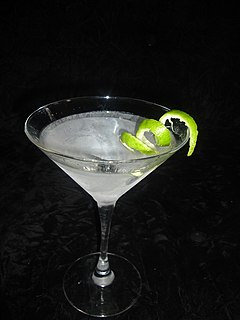
Various unique terminology is used in bartending.
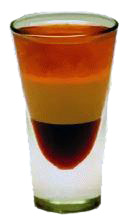
A layereddrink, sometimes called a pousse-café, is a kind of cocktail in which the slightly different densities of various liqueurs are used to create an array of colored layers, typically two to seven. The specific gravity of the liquid ingredients increases from top to bottom. Liqueurs with the most dissolved sugar and the least alcohol are densest and are put at the bottom. These include fruit juices and cream liqueurs. Those with the least water and the most alcohol, such as rum with 75% alcohol by volume, are floated on top.

A flaming drink is a cocktail or other mixed drink that contains flammable, high-proof alcohol, which is ignited prior to consumption. The alcohol may be an integral part of the drink, or it may be floated as a thin layer across the top of the drink. The flames are mostly for dramatic flair. However, in combination with certain ingredients, the flavor of the drink is altered. Some flavors are enhanced, and it may impart a toasted flavor to some drinks.

A bijou is a mixed alcoholic drink composed of gin, vermouth, and chartreuse. This cocktail was invented by Harry Johnson, "the father of professional bartending", who called it bijou because it combined the colors of three jewels: gin for diamond, vermouth for ruby, and chartreuse for emerald. An original-style bijou is made stirred with ice as Johnson's 1900 New and Improved Bartender Manual states "mix well with a spoon and serve." This recipe is also one of the oldest in the manual, dating back to the 1890s.
Lucas Bols N.V. is a Dutch public company in the business of production, distribution, sales and marketing of alcoholic beverages. It claims to be the oldest distillery brand in the world. Its brand portfolio consists of Bols, Galliano, Vaccari, Pisang Ambon, Gold Strike and a large group of Dutch genevers and liqueurs. It produces about 3 million cases a year, with yearly revenues exceeding 95 million euros.
A muddling spoon is a long handled spoon used in bartending. It resembles an iced tea spoon, but typically has a smaller head. Muddling spoons are not the same as muddlers, though both are used to make mixed (typically) alcoholic drinks. Also called a "cocktail mixing spoon", the extra-long handle makes it easy to reach the bottom of tall glasses and pitchers to thoroughly stir in and blend cocktails. The twisted handle assists in building visually attractive “stacked” or layered drinks and shots, known as pousse cafe. Gently pouring alcohol and other liquids over the twist eases them into the glass and, with practice, into their own layer.
Floating is a bartending technique where a liquor or ingredient is layered at the top of a drink. The cocktails or shots produced with this technique are known as either a Pousse-café or a layered drink. Although the amount of alcohol used in a float is only about half an ounce, it enhances the tone flavor of the drink at hand.

A Bloody Mary is a cocktail containing vodka, tomato juice, and other spices and flavorings including Worcestershire sauce, hot sauces, garlic, herbs, horseradish, celery, olives, salt, black pepper, lemon juice, lime juice and celery salt. Some versions of the drink, such as the "surf 'n turf" Bloody Mary, include shrimp and bacon as garnishes. In the United States, it is usually consumed in the morning or early afternoon, and is popular as a hangover cure.
A well drink or rail drink is an alcoholic beverage served using the lower-cost liquors stored within easy reach of the bartender in the counter "speed rail", "speed rack", or "well".

This is an index of drinking establishment-related articles.
An astro pop cocktail is a layered cocktail, mixed drink or shooter so named because it resembles the Astro Pop lollipop candy brand. Various recipes exist that use liquor and liqueurs to produce the drink. A version of the drink exists that is layered with red, white, and blue colors and served in a shot glass. It is a popular alcoholic beverage in some drinking establishments.
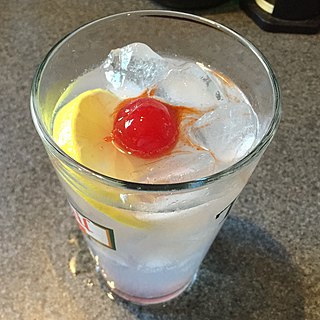
A John Collins is a cocktail which was attested to in 1869, but may be older. It is believed to have originated with a headwaiter of that name who worked at Limmer's Old House in Conduit Street in Mayfair, which was a popular London hotel and coffee house around 1790–1817.

Harry Johnson was an American bartender who owned and operated saloons across the US in the late 19th century and the early 20th century. He is best known for the New and Improved Bartenders' Manual, an influential book that contained many original cocktail recipes, as well as the first written recipes of such cocktails as the marguerite and a version of the martini. Perhaps even more importantly, it was the first book to offer bar management instructions. Johnson opened the first ever consulting agency for bar management. Imbibe magazine has called him one of the most influential cocktail personalities of the last 100 years, and he has been called "the father of professional bartending".
















